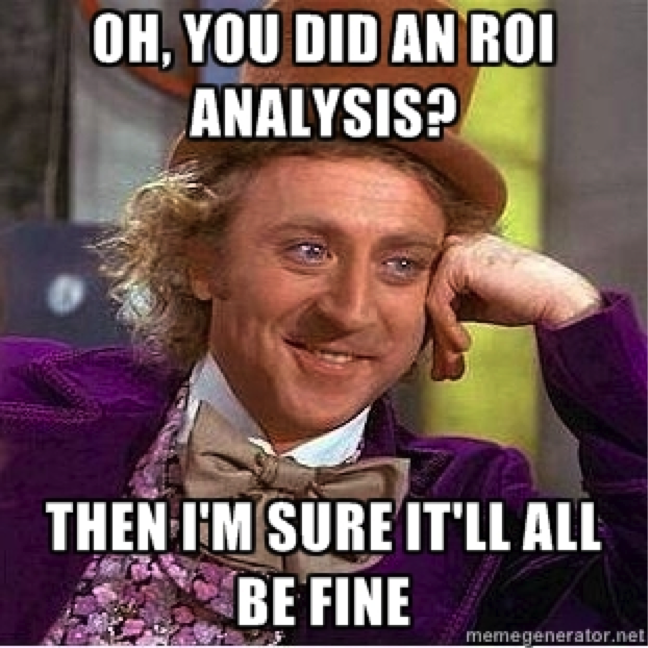 There’s nothing wrong with doing an ROI analysis—as a matter of fact, I think it’s a great idea. It’s just that the way that we, as an industry, typically use them is all backwards. They’re shouldn’t be a checkpoint; they’re a process.
There’s nothing wrong with doing an ROI analysis—as a matter of fact, I think it’s a great idea. It’s just that the way that we, as an industry, typically use them is all backwards. They’re shouldn’t be a checkpoint; they’re a process.
Let’s back up and define our terms. A Return on Investment (ROI) analysis is a financial model that calculates what net present value (NPV) implementing something, generally a technology, will deliver relative to its cost. This can be expressed as a percentage (“returns will be 183% of investment within 24 months”) or a time (“We’ll break even after 14 months, and after that everything is upside.”) Benefits need to be quantified in hard dollars: “better customer experience” doesn’t count as a return in an ROI model. A thoughtful ROI captures all sorts of investments—not just software licenses or subscriptions, but also hardware, implementation costs, support contracts, ongoing maintenance, training, and project management.
Right away, it’s clear that ROIs are tricky. Technology investments, by themselves, almost never generate benefits. Benefits only accrue from technology when it supports process improvements, and when people follow the new processes. Predicting the costs and benefits of an entire process change initiative is harder, and more speculative, than just adding up the costs of technology.
Still, as a sanity check, it’s a reasonable plan to come up with a rough estimate of ROI. In particular, you might find out that the implementation is so expensive that you won’t make up the investment in any reasonable time period. In this case, it’s good to stop and reconsider your initiative.
So, why do I list ROI as a “Metrics Myth?”
- The complexity of program-wide ROIs means that non-technology costs tend to get swept under the rug, and we pretend that the new knowledgebase, search engine, or CRM tool will magically shorten handle times or deflect contacts by itself. Needless to say, this kind of magic thinking isn’t conducive to good decision-making.
- Also, as an industry, we tend to know what good ROIs look like. A 10,000% or even 1,000% near-term return on investment isn’t seen as credible (although knowledge programs can, in fact, do this!) A near break-even ROI isn’t compelling. Spreadsheets make it easy to change assumptions to see what happens. So, of course, program teams all turn in ROIs that are high enough to be interesting, but not so high as to look bogus. I’m not accusing anyone of fudging the numbers, and I’m sure we all have the best of intentions, but it’s remarkable how…consistent…the ROIs I see are. This is probably why KM and HR thought leader Hubert St. Onge describes ROI analyses with a single, earthy, Anglo-Saxon word.
- At any given time, there are probably 50 initiatives that have positive near-term ROI. But the organization only has the ability to absorb so much change in the near term. So, which of these 50 initiatives will it implement? I guarantee you that the VP of Support and CFO will not rank order the candidates on the basis of calculated ROI. They’ll find the financially attractive opportunities that best line up with the organization’s strategic goals and initiatives. In executive decision-making, estimated hard dollars are less important than strategic alignment, perhaps because no one really trusts the hard dollar estimates, and perhaps because the strategic objectives are seen as the big opportunity for making money.
The bottom line is, do an ROI to sanity check your initiative, but spend more time on the strategic framework—how you explain how the initiative, process and technology together, will move the needle for the organization’s strategic goals.
Perhaps the saddest fact about ROI analyses is that, once the program is approved, they’re generally filed away and forgotten about. This is a missed opportunity! The ROI analysis contains specific assumptions and models about how the business will improve. Once the program goes live, you have a wonderful opportunity to test those assumptions in the real world. Are things working as you expected? Great! Now figure out what to do to make it even better. Are things falling short of expectations? Great! Your ROI gives you a model that will help you troubleshoot and make incremental improvements, or perhaps invalidate certain assumptions and help you pivot to a better approach. Either way, facts are friends: by overlaying reality on your ROI, you’ll learn lots about how your business really works, and how to make things even better.